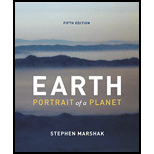
The manner through which a clastic sedimentary rock forms from its unweathered parent rock.
Answer to Problem 1RQ
The broken fragments from the parent rock would be physically and chemically weathered due to which these break down into detrital materials, clay, and dissolved ions. The weathered grains would be eroded away from the parent rock and transported to a far place by different agents such as the river, wind or glacier. When the transporting agent drops or deposits the sediments it carried, it would progressively get buried, compacted, lithified, and cemented to form different types of clastic sedimentary rocks.
Explanation of Solution
A clastic sedimentary rock reveals its source and depositional environment from the specific characteristics such as grain size, sorting, composition, angularity, roundness, maturity and the type of cement it possess. Most of the rock fragments many be derived from the cliff face of mountains.
A large chunk of rock broken off from a cliff would fall or roll down to the base of the mountain. During its journey to the mountain base, it could have undergone collisions with many obstacles due to which it might have broken into smaller angular pieces with sharp edges; however, some of the pieces would lose its sharpness due to abrasion.
The rock fragments would be subjected to physical weathering due to which it gets broken down into even smaller particles and chemical weathering because of which many minerals are formed and the existing minerals like the feldspars would undergo alteration to clay that gets washed away easily. The weathered fragments may be further eroded and transported by agents such as the wind, water and glaciers.
During the transportation process, the sediments may attain more sphericity and maturity. It will ultimately contain the resistant quartz grains that are mostly sand sized and rounded. When the transporting agents lose their capacity to carry the sediments further, they start depositing the sediments at different places. While depositing, the larger grains such as the pebbles and cobbles will be laid down at first followed by the medium ones like the sand particles and the finer particles such as silt and clay.
When the deposited sediments of different sizes get buried under more sediments, get compacted, cemented and lithified, they develop into various types of clastic sedimentary rocks. For instance, if the angular pieces of rock that have not undergone much polishing and still own angular edges, get cemented, it would give rise to the clastic sedimentary rock, breccia. The larger particles such as pebbles and cobbles lithifies into a conglomerate. The sand grains get compacted to form sandstone, when the silt particles get compacted and lithified, a siltstone is generated and if the mud lithifies, it forms a shale or mudstone.
Want to see more full solutions like this?
Chapter 7 Solutions
Earth: Portrait of a Planet (Fifth Edition)
 Applications and Investigations in Earth Science ...Earth ScienceISBN:9780134746241Author:Edward J. Tarbuck, Frederick K. Lutgens, Dennis G. TasaPublisher:PEARSON
Applications and Investigations in Earth Science ...Earth ScienceISBN:9780134746241Author:Edward J. Tarbuck, Frederick K. Lutgens, Dennis G. TasaPublisher:PEARSON Exercises for Weather & Climate (9th Edition)Earth ScienceISBN:9780134041360Author:Greg CarbonePublisher:PEARSON
Exercises for Weather & Climate (9th Edition)Earth ScienceISBN:9780134041360Author:Greg CarbonePublisher:PEARSON Environmental ScienceEarth ScienceISBN:9781260153125Author:William P Cunningham Prof., Mary Ann Cunningham ProfessorPublisher:McGraw-Hill Education
Environmental ScienceEarth ScienceISBN:9781260153125Author:William P Cunningham Prof., Mary Ann Cunningham ProfessorPublisher:McGraw-Hill Education Earth Science (15th Edition)Earth ScienceISBN:9780134543536Author:Edward J. Tarbuck, Frederick K. Lutgens, Dennis G. TasaPublisher:PEARSON
Earth Science (15th Edition)Earth ScienceISBN:9780134543536Author:Edward J. Tarbuck, Frederick K. Lutgens, Dennis G. TasaPublisher:PEARSON Environmental Science (MindTap Course List)Earth ScienceISBN:9781337569613Author:G. Tyler Miller, Scott SpoolmanPublisher:Cengage Learning
Environmental Science (MindTap Course List)Earth ScienceISBN:9781337569613Author:G. Tyler Miller, Scott SpoolmanPublisher:Cengage Learning Physical GeologyEarth ScienceISBN:9781259916823Author:Plummer, Charles C., CARLSON, Diane H., Hammersley, LisaPublisher:Mcgraw-hill Education,
Physical GeologyEarth ScienceISBN:9781259916823Author:Plummer, Charles C., CARLSON, Diane H., Hammersley, LisaPublisher:Mcgraw-hill Education,





